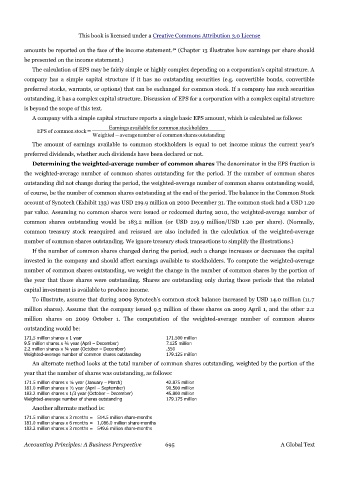Page 694 - Accounting Principles (A Business Perspective)
P. 694
This book is licensed under a Creative Commons Attribution 3.0 License
52
amounts be reported on the face of the income statement. (Chapter 13 illustrates how earnings per share should
be presented on the income statement.)
The calculation of EPS may be fairly simple or highly complex depending on a corporation's capital structure. A
company has a simple capital structure if it has no outstanding securities (e.g. convertible bonds, convertible
preferred stocks, warrants, or options) that can be exchanged for common stock. If a company has such securities
outstanding, it has a complex capital structure. Discussion of EPS for a corporation with a complex capital structure
is beyond the scope of this text.
A company with a simple capital structure reports a single basic EPS amount, which is calculated as follows:
Earningsavailablefor common stockholders
EPS of common stock=
Weighted−averagenumber of common sharesoutstanding
The amount of earnings available to common stockholders is equal to net income minus the current year's
preferred dividends, whether such dividends have been declared or not.
Determining the weighted-average number of common shares The denominator in the EPS fraction is
the weighted-average number of common shares outstanding for the period. If the number of common shares
outstanding did not change during the period, the weighted-average number of common shares outstanding would,
of course, be the number of common shares outstanding at the end of the period. The balance in the Common Stock
account of Synotech (Exhibit 133) was USD 219.9 million on 2010 December 31. The common stock had a USD 1.20
par value. Assuming no common shares were issued or redeemed during 2010, the weighted-average number of
common shares outstanding would be 183.2 million (or USD 219.9 million/USD 1.20 per share). (Normally,
common treasury stock reacquired and reissued are also included in the calculation of the weighted-average
number of common shares outstanding. We ignore treasury stock transactions to simplify the illustrations.)
If the number of common shares changed during the period, such a change increases or decreases the capital
invested in the company and should affect earnings available to stockholders. To compute the weighted-average
number of common shares outstanding, we weight the change in the number of common shares by the portion of
the year that those shares were outstanding. Shares are outstanding only during those periods that the related
capital investment is available to produce income.
To illustrate, assume that during 2009 Synotech's common stock balance increased by USD 14.0 million (11.7
million shares). Assume that the company issued 9.5 million of these shares on 2009 April 1, and the other 2.2
million shares on 2009 October 1. The computation of the weighted-average number of common shares
outstanding would be:
171,5 million shares x 1 year 171.500 million
9.5 million shares x ¾ year (April – December) 7.125 million
2.2 million shares x ¼ year (October – December) .550
Weighted-average number of common shares outstanding 179.125 million
An alternate method looks at the total number of common shares outstanding, weighted by the portion of the
year that the number of shares was outstanding, as follows:
171.5 million shares x ¼ year (January – March) 42.875 million
181.0 million shares x ½ year (April – September) 90.500 million
183.2 million shares x 1/3 year (October – December) 45.800 million
Weighted-average number of shares outstanding 179.175 million
Another alternate method is:
171.5 million shares x 3 months = 514.5 million share-months
181.0 million shares x 6 months = 1,086.0 million share-months
183.2 million shares x 3 months = 549.6 million share-months
Accounting Principles: A Business Perspective 695 A Global Text

